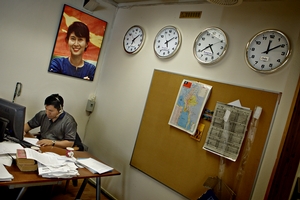Khin Maung Win and his 15 colleagues report the news from a land without press freedom in a studio in Norway.
 xxx  Htet Aung Kyaw has Aung San Suu Kyi watching over his work, and if he turns his back, he will easily know what time it is in Rangoon. Photo: Marius Sunde Tvinnereim. |
In a peach-coloured concrete building in the Norwegian capital Oslo, a group of Burmese journalists are sending news updates and stories about Burma to their home country, and the world. Burma?s only free broadcaster has been based in Oslo for 16 years. The non-profit organization, which survives on support from 13 different organizations and governments, amongst them the Norwegian ministry of foreign affairs, struggle to provide accurate and unbiased news to the people of Burma. - There are no free media organizations in Burma, everything is controlled by the military junta, and is pure propaganda. We have 60 journalists based in Burma, but they have to work undercover, and taking a great risk. About 20 of our journalists in Burma have been arrested, says Khin Maung Win, deputy executive director.
Crazy change of capital
The television studio is small, consists of a desk and two chairs, and a robot camera, which is controlled from another room. The lights are off, but we can see the background, a pale blue map of Burma. - This is Rangoon, the real capital of Burma, he says, and points to a city in the south of the country. - But the military junta moved the capital from Rangoon to Naypyidaw in 2002. - What do the Burmese people think about that??
- They think it is crazy. It is crazy!?
Rangoon is the capital, not Naypyidaw.?
Maung Win left Burma years ago, and travelled to Norway with his wife and daughter. His parents?
and siblings are still in Burma, and he doesn?t peak with them on the phone regularly.?
- I call them sometimes, but not too often. The government in Burma knows who I am, so I will?
put them in a dangerous position if I call them often, he says.
Chief and cameraman
In a closed room next to the little kitchen, the chief editor, Aye Chan Naing, is busy controlling the robot camera in the studio. - When you work with the Democratic Voice of Burma, you have to do all kinds of jobs, Maung Win explains. - We?re not enough people, so all the employees have to be able to do all kinds of jobs. The television anchor is also the World News editor, for instance. Naing nods, and focuses on one of the nine big screens in his little control room. Right now he?s the cameraman, later today he will be the chief again.
Burma/Myanmar
Capital city: Naypyidaw (since 2005, before: Rangoon/Yangon.)
Population: 52 million
Religion: 89 percent Buddhism, 4 percent Christianity, 4 percent Islam
Languages: Burmese (official language), Shan, Karen, Kayah.
GDP per capita: 1039 USD Source: Caplex.no
Brief history of Burma
The area that today is Burma, was occupied by the British during three wars in 1826, 1852 and 1855. From 1886 the country was a part of the British India, and became a province of its own with local government in 1937. Occupied by Japan during WW2, and given sovereignty when the war ended. Military coup led by Ne Win in 1962, since then the country has been ruled by a military government, with only one party. The president (since 1992), is Than Shwe. Source: Caplex.no

